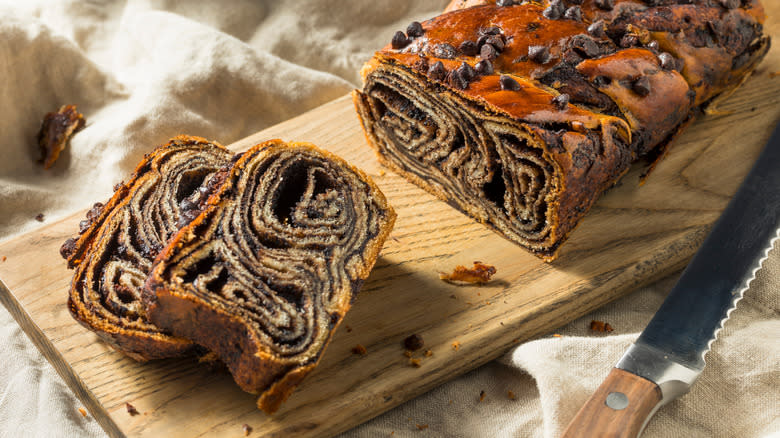The BBQ Tool That Will Help You Know When Babka Is Done Baking

Baking a classic babka is a complicated process that requires many steps and can take the better part of a day. If you're going to the effort of baking fresh babka, a Jewish cake typically served on the Sabbath or during holidays, the last thing you want is for it to be burnt or underbaked. Sure, you can stick a toothpick in the dough to see if it's done, but this method is not always accurate, particularly with taller or denser baked goods. Instead, you should turn to the world of barbecue for the solution.
Chef Mark Strausman of Mark's Off Madison (M.O.M.) -- formerly Fred's at Barneys New York -- shared his clever trick with Mashed: Use a meat thermometer. In addition to offering classic Italian and European dishes, Strausman's restaurant serves up the traditional Jewish recipes of his youth. So, he knows his babka from his challah, and Strausman says that babka can be particularly deceiving.
He explains, "Because babka is dense and filled, you can't tell if it's done by looking at it. The crust might look done, but you can't tell what's going on on the inside. You need to make sure it's cooked in the middle to an internal temperature of 190 degrees [Fahrenheit]. That means you need to test it by sticking a meat thermometer into the middle of the loaf. Meat thermometers are thin, and the small hole it makes should close up as the loaf continues to cook."
Read more: The Best Chocolate Desserts You'll Ever Taste
The Right Thermometer For The Job

As Chef Mark Strausman explained, babka can be difficult to get right. The dish sits in a weird gray area between bread and cake, but given that it rises from yeast, babka in many senses is a bread by definition. The dough for babka (which is made from flour, yeast, butter, salt, and sugar) is twisted to give the dish its signature layers, filled with chocolate, fresh or dried fruit, poppy seeds, or mild cheese. Given its complexity and variety of textures, the best way to get a reading is to use a thermometer.
Look for a thermometer that's waterproof, as the inside of babka -- if raw -- can be quite moist. Likewise, you want a thermometer capable of exceeding the optimal temperature for babka, with a probe long enough to reach the center. Meat thermometers work well because they're thin, they're designed to resist high temperatures, and you're likely to have one around the house. However, they sell thermometers specifically designed for bread and dough, as well.
When gauging the temperature of the babka, you want to be certain you are taking the temperature from the middle and trying in a couple of spots to account for the babka's variegated texture. To ensure all parts are evenly cooked, you want a temperature of between 185 and 210 degrees Fahrenheit. A perfectly cooked babka is worth the extra trouble, and this simple trick ensures you get it right.
Read the original article on Mashed.

